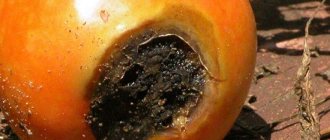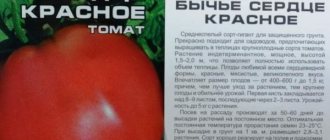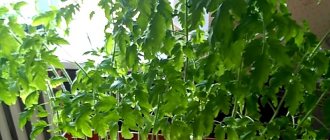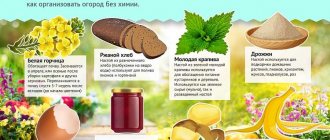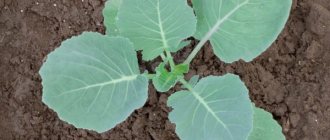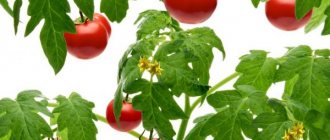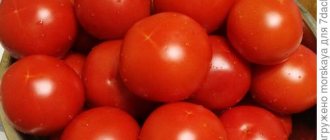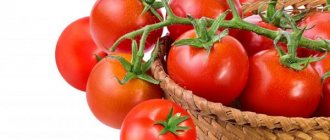Vegetable growing » Tomatoes
0
6023
Article rating
Kira Stoletova
Tomatoes require fertilizer to grow well. One of the effective ones is feeding tomatoes with ammonia. But not everyone knows what it is used for and how to do it correctly. Let's consider options for using such fertilizer.
Fertilizing tomatoes with ammonia
Beneficial features
Ammonia is an aqueous ammonia solution. It dissolves well in water and has a characteristic pungent odor, which in high concentrations can even cause poisoning. The main element in ammonia is ammonia. When ammonia enters the soil, it quickly penetrates even into the deepest layers and intensively nourishes the root system of plants. As a result, the growth of the tomato bush increases, juicy green leaves are formed, and the bush looks attractive.
Ammonia does not contain any side additives or chemically hazardous substances; it does not poison the soil and does not accumulate in it. With foliar feeding, due to its pungent odor, alcohol serves as a reliable insecticide; insects and pests are not afraid of plants.
Is it possible to feed tomatoes with ammonia and what does it do?
Why ammonia is valuable as a fertilizer for tomatoes:
- Nitrogenous substances in it are in a form that is easily absorbed by plants; their additional processing by bacteria is not required.
- It very quickly, almost instantly saturates the soil with nitrogen.
- Perfectly disinfects the soil, helps fight pests and fungal microorganisms.
- The growth of the above-ground parts of tomatoes is significantly accelerated thanks to the “building material” nitrogen.
- Ammonia is absolutely harmless, both for tomatoes and for plants that are nearby.
- It is very cheap and easy to use.
Pros and cons of using
Ammonia as a fertilizer has received many positive responses. He is praised for:
- quick result. The effect can be replaced already from the second feeding;
- maintaining the immune capacity of plants, reducing the risk of fungal and viral infections;
- minimum consumption. To prepare the fertilizer, no more than 2 tablespoons of the substance are required.
However, the additive has some negative consequences due to an excess of ammonia in the soil. First of all, this is the excessive formation of green mass. In another way, they say that tomatoes “fatten” - fruiting does not occur, but a large number of leaves form on the stem.
To avoid this, fertilizing is carried out in compliance with certain proportions and with a given frequency. In no case should you neglect the recommendations and use ammonia thoughtlessly for feeding. This will lead to virtually no harvest.
When is fertilizer needed?
Next we will describe the signs of acute nitrogen deficiency. If you notice them on your tomatoes, you should treat them as quickly as possible:
- The lower leaves began to turn yellow or turned pale and light green.
- The green mass grows slowly, new leaves grow very small.
- The stems become thinner and brittle.
- Tomato bushes have completely stopped growing.
- Plants do not bloom or there are very few flowers.
- Tomatoes react negatively to the slightest weather changes and temperature fluctuations, the leaves wither, dry out, turn yellow, and the bushes begin to disappear.
Attention! All of these signs are symptoms of an acute lack of nitrogen in the soil.
They are the same for both adult tomato bushes and seedlings.
Ammonia against tomato pests
In the spring, after tomatoes are transplanted into a greenhouse or open ground, they can be attacked by insects. Tomatoes are often attacked by aphids, midges, caterpillars, and mites. To repel pests, prepare the following remedy:
- 2 tbsp. ammonia;
- a bucket of water.
Dissolve the alcohol in water, pour it into a spray bottle and irrigate the branches, leaves and stems of the plants. The first treatment is carried out 2-3 weeks after planting, and irrigation is repeated after 2 weeks.
Important! The water for making the product should be taken at room temperature. Too cold water can cause rot on the leaves.
What seedlings need to be fed?
The most common nitrogen-loving plants are:
- Cabbage, zucchini, eggplant, potatoes, pumpkin, rhubarb. Among the blooming ones: dahlias, roses, clematis and petunias. These plants need to be watered with a solution, both while they are at the beginning of growth and throughout.
For lovers of “average” strength:
- Garlic, carrots, cucumbers and tomatoes. They need to be fed nitrogen less often.
Plants with low nitrogen consumption include:
- onions, radishes and different types of salads. Such crops need to be fed only when necessary.
All plants of the legume family do not need nitrogen fertilizing.
Feeding methods
There are two main ways to apply fertilizers:
- Watering or applying fertilizer to the roots. When the solution is watered on the soil near the root.
- Foliar feeding. Then the plants are sprayed. When spraying plants, it is better to use a regular watering can. If you use a watering can that is equipped with a spray spout, most of the nitrogen will evaporate before it reaches the plant.
Types of tomato fertilizing
In most cases, ammonia is used in the first phase of cultivation. Fertilizers are applied by foliar and root methods. Both varieties are acceptable and good in their own way.
When foliar feeding, ammonia directly penetrates the pores of the leaves and stems and saturates them with nitrogen.
Root feeding is considered the standard method of obtaining nutrients and mainly feeds the root.
Foliar method
Irrigation with a weak ammonia solution can be carried out no earlier than 2 weeks after transplanting tomatoes. Take a tablespoon of alcohol per bucket of water. Stir quickly so that the ammonia does not have time to evaporate, and apply the solution to the leaves of the seedlings in the morning.
When used in the evening, moisture from the leaves may not completely evaporate, resulting in the formation of mold and mildew. Foliar feeding should be applied every week during May and June, but no more than 3-4 times during the entire growing period.
Root method
The breeding scheme for root feeding is as follows:
- 1 tbsp. ammonia;
- a bucket of warm water.
The freshly prepared additive is poured into tomato holes at the rate of at least 0.5 liters per bush. Then, to enhance the effect, the soil is mulched with sawdust or straw so that the moisture stays in the soil longer. The beginning of feeding is the end of May - the beginning of June with a frequency of 1 time in 10 days. Before flowering begins, no more than 3 feedings should be carried out.
A few words against
Not everything is as bad as described in this chapter. You can feed tomatoes with ammonia, but only if you do everything correctly. Before you run to the pharmacy for bottles of the drug, you should familiarize yourself with its features. And, perhaps, use saltpeter or urea as a source of nitrogen.
Why did large farms abandon fertilizing with ammonia as soon as other fertilizers became available? What can ammonia pose to modern gardeners? It has a number of disadvantages:
- High volatility. Losses of the active substance can amount to 3/4 during the processing of tomatoes. It evaporates especially intensively at high temperatures and during foliar feeding.
- Toxicity. The fumes can cause burns to the nasopharynx and respiratory tract, and if you work without protective glasses, you can remain blind. It is generally unacceptable to dilute the substance at home.
- To increase the nitrogen content in the soil in the fall, immediate digging is needed. On collective and state farms, after the tank spraying ammonia, there was equipment with a cultivator or harrow. Gardeners on private farms will also have to decide whether to invite relatives or a mini-tractor to help. It is impossible to postpone soil tillage “until tomorrow”, otherwise the nitrogen losses will be too great.
- If you feed tomatoes with a solution of high concentration, you can destroy them. At best, they will get ammonia poisoning, at worst, they will “burn” from a chemical burn. However, an overdose of any fertilizer is dangerous.
- The high cost of the drug. Yes, feeding tomatoes with ammonia is not cheap, although many sources declare it as a “penny remedy.” If you calculate the cost of ammonia and any other nitrogen fertilizer required to process 1 hundred square meters, the difference will be more than 10 times. And not in favor of ammonia. You just need to count not “by eye”, but based on fertilizer application rates.
- If the ammonia concentration is 10%, add 3 tablespoons of the drug to 10 liters of water. How much solution should be poured onto the site to saturate the soil with nitrogen? And who will carry buckets or watering cans in those areas whose owners cannot afford automatic irrigation, and even with the supply of fertilizers? Plus labor costs, pain in the back, shoulders, and arms.
- And the last thing, especially for owners of polycarbonate greenhouses. Ammonia vapor destroys this material.
It is impossible to feed tomatoes with a highly concentrated solution of ammonia to compensate for the volatility of the substance. Before it evaporates, the ammonia will have time to burn the leaves and roots of the plants. They will most likely die from a chemical burn.
Feeding tomato seedlings
To speed up the growth of seedlings, you can use ammonia. The concentration for young, immature plants should be less than for adults. You need to take a teaspoon of the substance for 8-10 liters of water. The resulting solution is used to water young seedlings, at least a month old. To stimulate stem growth, 2-3 feedings with an interval of 7-10 days will be enough.
Attention! When using ammonia, other nitrogen fertilizers are abandoned to avoid an excess of nitrogen.
What plants benefit from ammonia?
Ammonia supplies the plant’s “organism” with nitrogen, which is necessary for their growth. It actively affects the growth and health of plants such as:
- Flowers.
- Root vegetables (potatoes, eggplants).
- Garden crops (including peppers and tomatoes).
- Bulbous vegetable crops.
Also, ammonia is suitable for foliar feeding of flowers. Depending on the type of plant, the dosage of ammonia also changes. This is due to the fact that each plant has its own growth rate, which means the amount of feeding they need is completely different. Despite the fact that it is impossible to kill a plant with excess ammonia, using excess ammonia will not improve the result, and therefore will be useless.
During the flowering and fruiting period
To maintain the formation of ovaries, ammonia is necessary, but in smaller quantities. When flowers have formed on the tomato bushes, so that they do not fall off, prepare fertilizer:
- 10 liters of water;
- 1 tbsp. potassium sulfate;
- 1 tsp ammonia.
After dilution, water the plants at the roots with fertilizer once a week. Fertilizer can be used 2-3 times during the entire flowering period.
For already fruiting bushes, ammonia helps to increase the yield and improve its quality. You will need:
- tsp potassium sulfate;
- 1 tsp superphosphate;
- 1 tsp ammonia.
The amount of ingredients indicated is calculated for a bucket of water. Dissolve all the components and water the fruit-bearing plants under the stem. Repeat watering 10 days after the first time.
How to fertilize correctly?
These simple rules will allow you to fertilize as efficiently as possible and not harm the plants.
Fertilizing is carried out in calm, windless, warm, but not hot weather . Do not feed with ammonia in extreme heat from +28° and above.- Feeding in rainy, damp weather is unacceptable ; it is better to postpone it until another day if clouds gather.
- The best time to feed is before 10 am , that is, before the midday heat, and after 18 pm.
- An aqueous solution of ammonia is poured under the roots of each tomato bush . If these are young seedlings, then 0.5 liters are needed for each bush, if the plants are mature, pour 1 liter.
If the tomatoes were fed, and it rained within 8-9 hours after that, they did not have time to absorb nitrogenous substances. It is recommended to repeat feeding on the next day when there is no rain.
You will find more information about watering tomatoes with ammonia in the material at the link.
As a tomato ripening stimulator
To make tomatoes ripen faster, use ammonia-based root dressing. Dilute 20 milliliters in 10 liters of water and water already fruiting tomato bushes at the root every 3-4 days for 3 weeks. The color of the tomatoes will change with each application of fertilizer; the fruits themselves ripen in the shortest possible time and are ready for harvesting.
Find out how and why to use tomato tops in the garden.
Recipe for solution with proportions
Before you start processing crops, it is necessary to take into account the fact that not only a lack of nitrogen, but also its excess can negatively affect the yield.
Preparing a universal feeding solution is quite easy and does not take much time: mix 50 ml of ammonia with 4 liters of water. It is necessary to water the crop strictly only at the root. Such a small concentration will only be beneficial for both the soil and the fruit.
Reviews
Gardeners enjoy using the additive and speak only positively about it. According to most gardeners, ammonia fertilizing has a special effect on sluggishly growing plants whose leaves have yellow spots and dry tips. Literally 2-3 root or foliar fertilizing with ammonia - and the tomatoes are no longer recognizable: the yellowness instantly disappears, the stem becomes juicy and shoots upward.
However, experienced gardeners warn that ammonia should be used only if it is necessary. If the tomatoes are already growing well and look healthy, then there is no need for fertilizing.
Did you like the post? Add it to your favorites
All your articles will be on this page.
Send the article to your social network!
The benefits of ammonia
At the initial stage of development of any crop, nitrogen is required for growth and green mass gain. This trace element plays an important role in the formation of chlorophylls, without which the process of photosynthesis is impossible. A sufficient amount of nitrogen will ensure intensive development of stems and leaves, and subsequently provide a good platform for flowering and fruiting.
Features of this fertilizer
Ammonia (ammonium hydroxide solution) is an ammonia solution, its concentration is 10%, and the amount of nitrogen is 80-82%. The nitrogen in it is easily digestible. What gives this fertilizer an advantage over other nitrogen fertilizers such as:
- manure;
- ammonium nitrate;
- urea.
To break down microelements in them, it takes time from three weeks to several months. The ammonia solution has an immediate effect. The nitrogen in this fertilizer is volatile and does not pollute the soil; this fertilizer is environmentally friendly and safe.
What fertilizers do tomatoes and peppers need?
In this section of the article we will talk in detail about what kind of fertilizers the crops of interest to us need at the seedling stage.
Nitrogen
The first substance that must be fed to the mentioned vegetables is, of course, nitrogen. It is he who influences such indicators of the health of seedlings of the previously listed crops, such as:
- stem thickness;
- brightness of color;
- juiciness of foliage.
Nitrogen is an essential element required by tomatoes.
Provided that there is not enough nitrogen for the crops we are interested in, the plants will grow thin and very vulnerable to diseases and attacks by garden pests.
However, it should be remembered that excessive supply of nitrogen to plants can also lead to negative consequences affecting the health of seedlings. Therefore, you need to feed plants wisely.
Phosphorus
The next substance that must be contained in the fertilizer for tomatoes and peppers is phosphorus. It is this element that supplies seedlings with energy for growth, in addition, it is also responsible for:
- formation of more peduncles;
- correct formation of the future decoration of your table: peppers and tomatoes.
Provided that phosphorus reaches the plant in insufficient quantities, most likely you will be left without a harvest, or you will receive fruits of poor size and taste.
Potassium
Potassium is a chemical element that is directly responsible for the progress in the growth and development of that part of the plant that is underground, that is, the roots. However, pepper requires the required substance in much larger quantities, but tomatoes at this stage of development also really need it.
Potassium is especially needed by plants at the growing stage of seedlings
It is potassium that helps plants take root not only in tubs at the stage of home germination, but also in the greenhouse after transplanting the seedlings to their permanent place of residence.
Section conclusions
So, having carefully studied this section, we can conclude that the main substances required by tomatoes and peppers at the growth stage in the form of seedlings are:
- potassium;
- nitrogen;
- phosphorus.
If you want to get a harvest, and a plentiful one at that, then it is better for you to make sure that the plants receive all the above-mentioned substances, since, as a rule, plants cannot obtain them in the required quantity naturally.
However, you should always remember that it is just as easy to overdo it with fertilizing seedlings as to underfeed it. Harm can be caused to plants even if you use folk remedies that are not concentrated and do not contain harmful impurities.
Such an unsightly appearance of seedlings can equally indicate both a lack of nutrients for it and an excess of them.
Excessive amounts of fertilizer can become poison rather than medicine for the plant, and it will quickly become ill.
Before planting seedlings, it is very important to study the composition of the soil that you have dug or purchased for it (in the latter case it is easier to do this), since the prepared substrate may already contain a sufficient amount of the listed fertilizers
Unfortunately, it is difficult to determine the exact reason for this “behavior” of seedlings, since it could equally be a lack of fertilizers or a shortage of:
- Sveta;
- heat;
- liquids.
Think about how comfortable the conditions are at the point in the apartment where the plants are located, and then start experimenting with fertilizers
Feeding tomato and pepper seedlings with yeast
Good additives are yeast in dry or compressed form, which affect not the plants, but the microorganisms in the ground that produce nitrogen.
It is important not to use the product constantly; for example, during the entire growth period, use this fertilizer only twice. Experienced gardeners recommend adding chicken manure after this procedure.
There are two known recipes for feeding tomato and pepper seedlings with yeast:
- Dry product.
Dissolve 100 g of the substance in 10 liters of water and add 2-3 tbsp. spoons of sugar. The duration of infusion is 2-3 hours, and then water at the root using 0.5 tbsp. for each tomato and pepper bush. - Pressed product.
Feeding tomato and pepper seedlings with folk remedies allows you to prepare the following solution: dissolve 300 g of yeast in 5 liters of water and leave for 24 hours. After this, dilute the solution with 10 liters of water.
